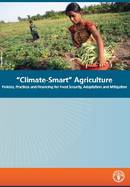Publications
The report contains the proceedings of the first workshop of a joint project by Zambia's Ministry of Agriculture and Livestock (MAL), The Food and Agriculture Organization of the United Nations (FAO) and The CGIAR programme on Climate Change, and Agriculture and Food Security (CCAFS) who are collaborating on developing and quantifying participatory scenario analysis under an EC funded project that will contribute to Zambia, having the tools, knowledge and capacities to adopt, advance, scale up and roll out solutions towards Climate-Smart Agriculture (CSA).
As renewed international efforts are needed to curb greenhouse gas emissions, the livestock sector can contribute its part. An important emitter of greenhouse gas, it also has the potential to significantly reduce its emissions. This report provides a unique global assessment of the magnitude, the sources and pathways of emissions from different livestock production systems and supply chains. Relying on life cycle assessment, statistical analysis and scenario building, it also provides estimates of the sector’s mitigation potential and identifies concrete options to reduce emissions. The report is a useful resource for stakeholders from livestock producers to policy-makers, researchers and civil society representatives, which also intends to inform the public debate on the role of livestock supply chains in climate change and possible solutions.
This paper examines some of the key technical, institutional, policy and financial responses required to achieve this transformation. Building on case studies from the field, the paper outlines a range of practices, approaches and tools aimed at increasing the resilience and productivity of agricultural production systems, while also reducing and removing
emissions. The second part of the paper surveys institutional and policy options available to promote the transition to climate-smart agriculture at the smallholder level. Finally, the paper considers current financing gaps and makes innovative suggestions regarding the combined use of different sources, financing mechanisms and delivery systems.




